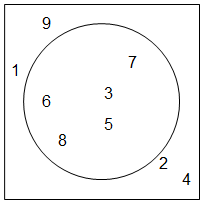
Produced by Charles Wells Revised 2016-07-23 Introduction to this website website TOC website index blog Back to head of sets chapter
This section describes certain common images and metaphors we have for sets – and their dangers.
The set $A:=\{3,5,6,7,8\}$ is a mathematical object.
The set $\mathrm{R}$ of all real numbers is a single math object with unimaginably many elements. You may think it impossibly hard to think of all the real numbers at once. But $\mathrm{R}$ is just one math object. You don’t have to think about all the real numbers at once to think about $\mathrm{R}$, any more than you have to think about all the molecules of water in the Pacific Ocean at once to think about the Pacific Ocean.
A set is
one mathematical object:
not many, not a bunch, but one object.
When you visualize the set $\{3,5,6,7,8\}$, the image you have may be the notation “$\{3,5,6,7,8\}$”. It is not entirely bad to visualize the notation when you think of this set, but remember that the notation has an irrelevant feature, namely the order in which the elements are written. The set $\{3,5,6,7,8\}$ is the same set as the one denoted by $\{3,6,7,5,8\}$, but the notation $\{3,5,6,7,8\}$ is not the same as the notation $\{3,6,7,5,8\}$. So it is wrong to think that the notation is the set.
Similarly, for real $x$, $\left\{ x|x\gt6 \right\}=\left\{ x|x\ge 6\text{ and }x\ne 6 \right\}$ even though the notation before the equals sign is different from the notationa after it.
The same set can be described by many different notations.
You can think of a set as a container that holds all its elements. This metaphor is good in some ways and bad in others.
Venn Diagrams give a useful picture of relationships between a few sets portrayed as points inside a circle (or other closed curve). The circle is then a container and the elements of the set are shown as points inside the circle.

The circle in the Venn diagram above represents the set $\{3,5,6,7,8\}$ shown as a subset of the integers between $1$ and $9$ inclusive. The element $3$ is shown as above $5$ and $7$ is northeast of $5$, and both those facts are completely irrelevant!
There is no good way to represent a finite set
that does not have irrelevant information
such as the location of the elements.
I prefer to think of the set $A=\{3,5,6,7,8\}$ as a mathematical object that has a special relationship with the numbers $3$, $5$, $6$, $7$ and $8$ that it does not have with any other objects. My mental image is a node called $A$ that has wires or arrows connecting that node to those five numbers and to nothing else. Those numbers can be moved around in the picture but that makes no difference – all that counts is the connections. (In that sense this picture is a directed graph.)

You may see a similarity between this and a pointer in a computer language. Typically a pointer in those languages will point to the head of a list and each entry in the list will point to another one. But the proper image for a set is that the pointer points to each one of them without preference – there is no ordering, implicit or otherwise. Another difference is that for sets, unlike computer language pointers, two different sets cannot point to exactly the same bunch of elements.
This work is licensed under a Creative Commons Attribution-ShareAlike 2.5 License.